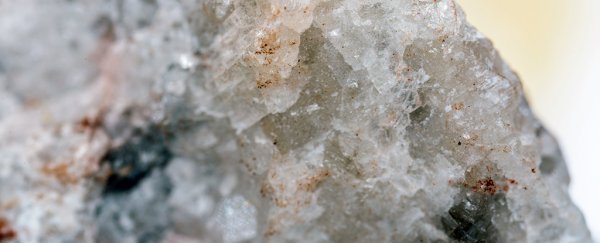Scientists just worked out a way of rapidly producing a mineral capable of storing carbon dioxide (CO2) - giving us a potentially exciting option for dealing with our increasingly overcooked planet.
Magnesite, which is a type of magnesium carbonate, forms when magnesium combines with carbonic acid - CO2 dissolved in water. If we can produce this mineral at a massive scale, it could safely store large amounts of carbon dioxide we simply don't need in our planet's atmosphere.
Developing the process to an industrial level is still some way off, but the new research has cracked the fundamentals of magnesite production, explaining how it crystallises naturally at low temperatures.
That process typically takes a very long time, but with the addition of polystyrene microspheres as catalysts, scientists were able to form magnesite in just 72 days. Since catalysts don't get depleted in the reaction, the team is working on finding ways to reuse these microspheres.
"Firstly, we have explained how and how fast magnesite forms naturally," says lead researcher and environmental geochemist Ian Power, from Trent University in Canada. "This is a process which takes hundreds to thousands of years in nature at Earth's surface."
"The second thing we have done is to demonstrate a pathway which speeds this process up dramatically."
Spiking carbon dioxide levels are one of the main drivers of climate change, increasing temperatures by trapping more of the heat from the Sun on the planet's surface. As well as calling for humanity to pump out less CO2 in the first place, scientists are also looking into ways of pulling it out of the atmosphere.
It's a process known as carbon sequestration and it's something magnesite does naturally. Being able to make the mineral in the lab could be a major step forward in terms of how effective carbon sequestration might eventually be.
"Using microspheres means that we were able to speed up magnesite formation by orders of magnitude," says Power.
"This process takes place at room temperature, meaning that magnesite production is extremely energy efficient."
 Magnesite sediments. (Ian Power)
Magnesite sediments. (Ian Power)
While carbon sequestration sounds promising in theory, the problem is finding methods that are cheap and practical enough to make a substantial amount of difference to levels of CO2 in the atmosphere.
Recent research suggests there's now more CO2 in the air than at any point in the last 800,00 years – 410 parts per million (ppm). At the moment, we're all pushing out an extra 40 million tonnes of carbon dioxide a year.
With a tonne of naturally-occurring magnesite able to capture around half a tonne of CO2, we're going to need a lot of magnesite, and somewhere to put it all as well. As with other carbon capture processes, it's not yet clear whether this will successfully scale up as much as it needs to.
That said, these new discoveries mean lab-made magnesite could one day be helpful – it puts the mineral on the table as an option for further investigation.
"For now, we recognise that this is an experimental process, and will need to be scaled up before we can be sure that magnesite can be used in carbon sequestration," says Power.
"This depends on several variables, including the price of carbon and the refinement of the sequestration technology, but we now know that the science makes it do-able."
The research has been presented at the Goldschmidt conference in Boston. You can read the abstract online.
